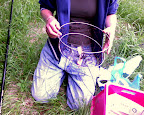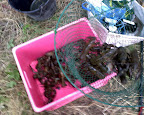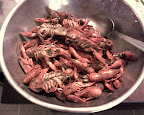The weekly markets are butter to Crozefond’s bread. No fewer than three weekly markets are attended during the warmer months. The markets begin at Villeneuve-sur-lot on Wednesday morning. The marathon continues Thursday morning at Bordeaux before climaxing at an evening market on the way back to the farm Thursday night. Each market has its distinct dynamics.
Thirty minutes away from the farm, at Villeneuve, Mami and Regine lend a feminine sensibility together with a couple of the granddaughters. The market (what few minutes I experienced) has an altogether laid-back feel, though it has a fair number of producers. Papi’s brother, along with several other produce stands, sell fruit and vegetables. There’s a guy who makes great chevre (goat cheese), a fishmonger (if I remember correctly), and the occasional staples-peddler (salts, vinegars, etc).
Bordeaux is a much larger town, and is three hours away (meaning getting up at 3:45 to load up the cold goods and get the camion rolling). This market, at least when stagiares are around, has a  different, more intense feel, even with fewer vendors. Bordeaux is where Vincent tends to take the stagiares, and is the market I became most familiar with. It’s full of characters. Before we’ve even arrived, groupies are gathered at our parking spot. Sweet arthritic women and flamboyant old men know the stand’s workings better than do the stagiares, and get down and dirty helping us set up. They do this for nothing tangible in return. Julie, a psychology student at Bordeaux, works weekly to earn some extra euros. She’s quick on her toes: she seems comfortable dancing around the occasional harmless chauvinistic banter.
different, more intense feel, even with fewer vendors. Bordeaux is where Vincent tends to take the stagiares, and is the market I became most familiar with. It’s full of characters. Before we’ve even arrived, groupies are gathered at our parking spot. Sweet arthritic women and flamboyant old men know the stand’s workings better than do the stagiares, and get down and dirty helping us set up. They do this for nothing tangible in return. Julie, a psychology student at Bordeaux, works weekly to earn some extra euros. She’s quick on her toes: she seems comfortable dancing around the occasional harmless chauvinistic banter.
Then there’s her occasional patient-to-be, like Chella, who announced her distaste for Americans upon meeting me. When she learned my ethnic background she tried to redeem herself, but ultimately seemed confused that I consider myself an Israeli despite Arab roots. The next week, before any greetings or pleasantries, she chastised me for improperly returning her bicycle after borrowing the previous week. It turns out I left the seat lowered (my fault, yes, though the quick-release fastener should have rendered the adjustment easy as riding a bike) and for breaking her brakes (this one an unfounded accusation). Alas, some people, one learns, are best just left alone.
At 10:30am, our halfway point, we join forces with the winemakers to our side and set up a snack table behind the scenes. Wine glasses  fill up, bread sliced, cheese and ham brought out. A couple of bicycle-mounted policemen and -women are regulars, but mostly older men show up, talk trash (in French the expression literally translates to “make the mayonnaise”), and get their morning buzz on. It’s very convivial, and poles apart from anything we’ll ever see at the Union Square market. Around two o’clock, we eat again, picking at leftover pizzas and quiches, rinsing with more wine (or coffee). Then we pack up and head to the second market of the day—an evening market complete with entertainment, booze, and lots more to eat.
fill up, bread sliced, cheese and ham brought out. A couple of bicycle-mounted policemen and -women are regulars, but mostly older men show up, talk trash (in French the expression literally translates to “make the mayonnaise”), and get their morning buzz on. It’s very convivial, and poles apart from anything we’ll ever see at the Union Square market. Around two o’clock, we eat again, picking at leftover pizzas and quiches, rinsing with more wine (or coffee). Then we pack up and head to the second market of the day—an evening market complete with entertainment, booze, and lots more to eat.
Having spent the last twelve hours on the road and at the market earns one the privilege of relaxing a bit—walking around and sampling the fare. Mami introduced me to her cousins and various townsfolk. I chatted a fair bit with Serge, the mayor of Savignac who, along with the Pozzers, is entertaining and entertained by the possibility of me someday settling down in the area (have I mentioned I love it here?). There’s altogether too much food to go around. Working with one of the vendors has its privileges, such as grilled skewers of foie gras-studded duck breast, and pretty much all the wine one can drink. The British invasion in the area makes for a number of people with whom to practice my native tongue. And  there’s the evening show—sometimes rock, sometimes rather awful folky stuff. Turnout reaches 1000 on busy weeks, creating another amazing scene that brings out my American’s jealousy. All of this is picturesquely set on the Lot river, and brings one to dream of living on its bank (Mami’s keeping her eyes out for a suitable piece of land for me).
there’s the evening show—sometimes rock, sometimes rather awful folky stuff. Turnout reaches 1000 on busy weeks, creating another amazing scene that brings out my American’s jealousy. All of this is picturesquely set on the Lot river, and brings one to dream of living on its bank (Mami’s keeping her eyes out for a suitable piece of land for me).
At midnight commences a communal drunken chair-stacking, table-dragging orgy. We finally make it to sleep, a full twenty two hours after waking for the long day.
 (read: right side up, in the water) set them down in the muddy stream, wait a few minutes, and then pull them back onto land. The traps being little more than glorified nets, it was key to get it out of the water and onto land before the big bugs would crawl through the net and back to safety. We baited with some old sardines Claudette had in the freezer along with special crayfish (écrevisse) snacks (read: not-so-slim dry blood sausage slim jims). The little buggers preferred what probably more natural to them: the sardines (or maybe it had something to do with the snackies not being organic).
(read: right side up, in the water) set them down in the muddy stream, wait a few minutes, and then pull them back onto land. The traps being little more than glorified nets, it was key to get it out of the water and onto land before the big bugs would crawl through the net and back to safety. We baited with some old sardines Claudette had in the freezer along with special crayfish (écrevisse) snacks (read: not-so-slim dry blood sausage slim jims). The little buggers preferred what probably more natural to them: the sardines (or maybe it had something to do with the snackies not being organic).  We were worried at first that it’d go the way of my flopped turkey hunt last fall (no turkeys in sight, thanks), but after a few empty nets we caught onto their game, and ended up with something like 80 of the American guys (turns out they’re not native: they’re a pest that somehow got transplanted at some point—the better, I’m told, native crustaceans of bigger rivers are only allowed to be hunted one day each year). Cleaning them meant carefully grabbing the body with one hand (careful not to lose a finger in their pinching claws), and pulling out their middle tail-fin, vein (and digestive waste) included. Cooking them was deliciously straightforward: a hard sear, ample garlic and
We were worried at first that it’d go the way of my flopped turkey hunt last fall (no turkeys in sight, thanks), but after a few empty nets we caught onto their game, and ended up with something like 80 of the American guys (turns out they’re not native: they’re a pest that somehow got transplanted at some point—the better, I’m told, native crustaceans of bigger rivers are only allowed to be hunted one day each year). Cleaning them meant carefully grabbing the body with one hand (careful not to lose a finger in their pinching claws), and pulling out their middle tail-fin, vein (and digestive waste) included. Cooking them was deliciously straightforward: a hard sear, ample garlic and  parsley, and a flambé of Vincent’s prune (plum) eau de vie (literally: water of life, really: fire water). They yield even less than Maryland blue crabs, so you need to be prepared with a patient appetite and to make use of the guts, not just the tails. There were lots of mosquitoes and thorns about, but a hyper- (as they say around here) fun time.
parsley, and a flambé of Vincent’s prune (plum) eau de vie (literally: water of life, really: fire water). They yield even less than Maryland blue crabs, so you need to be prepared with a patient appetite and to make use of the guts, not just the tails. There were lots of mosquitoes and thorns about, but a hyper- (as they say around here) fun time. 